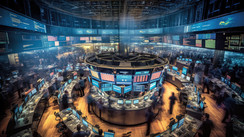An Introduction to Dow Jones Industrial Average (DJIA)
The Dow Jones Industrial Average, colloquially referred to as the Dow, stands as a prominent stock market index, mirroring the performance of 30 significant publicly-listed companies in the United States. Serving a similar function as the S&P 500, the DJIA provides a reliable indicator of the health of the stock market as a whole. Despite its fame, it's a surprising fact to many that this global standard comprises just 30 entities.
The Formation and Evolution of the DJIA
Our journey takes us back to May 26, 1896, the birth date of the DJIA, a brainchild of Charles H. Dow. Charles, a co-founder of Dow Jones & Company, had launched his first index in 1884, focused on 11 stocks related to transportation. He later modified this precursor, branding it as the Dow Jones Rail Average, which saw a name upgrade in the 1970s to the Dow Jones Transportation Average, to encompass diverse transportation modes, including air freight.
Observing the rapidly accelerating value of industrial firms surpassing railroads, Charles designed a fresh index featuring 12 companies' stocks, christening it the Dow Jones Industrial Average (DJIA). The DJIA initially encapsulated sectors like cotton, sugar, tobacco, and gas, with its computation depending on the total stock prices divided by the number of constituent companies. The inaugural stocks largely constituted commodities like cotton, tobacco, sugar, cattle, electricity, gas, lead, coal, iron, leather, and rubber, all of which were thriving, highly esteemed entities of the time. However, shifts in business fortunes and share prices eventually led to their replacement in the DJIA.
In 1916, the DJIA expanded to incorporate 20 stocks, reaching its current count of 30 by 1928. The selection criteria for inclusion isn't rigid, but generally mandates large, reputable companies with high share prices, reflecting a substantial chunk of the US's economic activities.
The Modern-Day DJIA: A Beacon for Blue-Chip Stocks
Today, the DJIA stands as a key benchmark for America's largest blue-chip stocks. It's closely monitored by investors keen to assess the overall performance of U.S. equities. Indexes like the Dow provide insights into a specific group of securities' price dynamics, emulating a certain sector, market, or even an entire economy. Hence, a plethora of indexes now exist, varying from the comprehensive U.S. stock market to global bond markets and even niche areas like gold.
In its contemporary avatar, the DJIA tracks 30 blue-chip stocks belonging to well-established companies with a robust performance history. These companies span multiple industries, including information technology, healthcare, and consumer discretionary, with transportation and utilities being the notable exceptions. The most recent index alteration occurred on August 31, 2020, when Amgen, Honeywell, and Salesforce were inducted, replacing ExxonMobil, Pfizer, and Raytheon.
The 30 Dow companies are now:
- Apple Inc. (AAPL)
- Boeing Co. (BA)
- Microsoft Corp. (MSFT)
- Amgen Inc. (AMGN)
- Walt Disney Co. (DIS)
- Travelers Cos. Inc. (TRV)
- Salesforce.com Inc. (CRM)
- Intel Corp. (INTC)
- Procter & Gamble Co. (PG)
- Coca-Cola Co. (KO)
- McDonald's Corp. (MCD)
- Visa Inc. Cl A (V)
- Cisco Systems Inc. (CSCO)
- Johnson & Johnson (JNJ)
- American Express Co. (AXP)
- International Business Machines Corp. (IBM)
- Walgreens Boots Alliance Inc. (WBA)
- Home Depot Inc. (HD)
- Goldman Sachs Group Inc. (GS)
- Merck & Co. Inc. (MRK)
- Honeywell International Inc. (HON)
- Walmart Inc. (WMT)
- Chevron Corp. (CVX)
- 3M Co. (MMM)
- Nike Inc. Cl B (NKE)
- JPMorgan Chase & Co. (JPM)
- UnitedHealth Group Inc. (UNH)
- Verizon Communications Inc. (VZ)
- Dow Inc. (DOW)
- Caterpillar Inc. (CAT)
Criticisms and Limitations of the DJIA
Despite its prominence, the DJIA faces criticism due to its calculation methodology. Higher-priced stocks exert a disproportionately larger influence on the DJIA, leading to distortions. This became evident when corporate events like stock splits and other transactions altered nominal share prices. This issue necessitates frequent changes to the DJIA divisor to account for such developments, leading many money managers to prefer other indexes that adjust for a firm's market capitalization, like the S&P 500.
How to Invest in the DJIA?
Mutual funds offer exposure to the DJIA, and purchasing shares in these funds is akin to owning parts of the Dow. Also available is an ETF trading under the ticker DIA, which mirrors Dow exposure. However, be wary of other ETFs claiming Dow exposure, as they could be leveraged or inverse ETFs.
The DJIA is a price-weighted index, meaning higher-priced stocks carry more weight. It doesn't factor in market capitalization (the total market value of all company shares), so companies with fewer but pricier shares have a more substantial impact on the Dow’s value than companies with numerous cheaper shares. This is unlike other indexes like the S&P 500 or the NASDAQ, which consider a company’s market capitalization when determining its influence on the index. This unique weighting methodology can lead the Dow to experience more volatility in the short term than market-cap-based indexes.
Comparing the DJIA to Other Major Indexes
The DJIA, the S&P 500, and the NASDAQ are among the most commonly used indexes for evaluating U.S. stock market performance.
DJIA vs. S&P 500
Given it tracks 500 of the largest publicly traded companies, the S&P 500 has a wider coverage than the DJIA. Unlike the Dow, it's market capitalization-weighted, making it potentially a better barometer of the overall stock market performance. Because of its price weighting, a high-priced share experiencing a minor fall in the Dow could have an exaggerated impact, especially if the company has a smaller market cap. This discrepancy between price weighting and market capitalization weighting can cause the DJIA to exhibit more short-term volatility than the S&P 500. Over the long term, however, both have shown similar performance.
DJIA vs. NASDAQ
The NASDAQ 100 tracks the 100 largest and most actively traded non-financial domestic and international companies listed on the NASDAQ Stock Market. Unlike the Dow but like the S&P 500, it's market-cap weighted and sets specific requirements for inclusion. However, it differs from both in its significant tech company skew and inclusion of some foreign companies. Consequently, the NASDAQ may offer more insight into the global tech industry's economic performance than the overall U.S. stock market. Over the past decade, the NASDAQ has outperformed the DJIA, primarily due to its heavy tech concentration.





